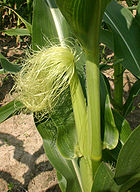
Stigma (botany)
Encyclopedia
The stigma is the receptive tip of a carpel, or of several fused carpels, in the gynoecium
of a flower
. The stigma receives pollen
at pollination
and it is on the stigma that the pollen grain germinates
. The stigma is adapted to catch and trap pollen with various hairs, flaps, or sculpturings. The pollen may be captured from the air (wind-borne pollen, anemophily
), from visiting insects or other animals (biotic pollination), or in rare cases from surrounding water (hydrophily
).
Stigmas can vary from long and slender to globe shaped to feathery.
Pollen is typically highly desiccated when it leaves an anther. Stigmas have been shown to assist in the rehydration of pollen and in promoting germination of the pollen tube. Stigmas also ensure proper adhesion of the correct species of pollen. Stigmas can play an active role in pollen discrimination and some self-incompatibility reactions
, that reject pollen from the same or genetically similar plants, involve interaction between the stigma and the surface of the pollen grain.
 The style connects the stigma to the ovary. Styles are always tube-like — either long or short. The style can be open (containing few or no cells in the central portion) or closed (densely packed with cells throughout). Pollen tubes grow the length of the style to reach the ovule
The style connects the stigma to the ovary. Styles are always tube-like — either long or short. The style can be open (containing few or no cells in the central portion) or closed (densely packed with cells throughout). Pollen tubes grow the length of the style to reach the ovule
s, and in some cases self-incompatibility reactions
in the style prevent full growth of the pollen tubes. Studies have shown that in some species, at least, the pollen tube is directed to the micropyle of the ovule by the style.
Gynoecium
Gynoecium is most commonly used as a collective term for all carpels in a flower. A carpel is the ovule and seed producing reproductive organ in flowering plants. Carpels are derived from ovule-bearing leaves which evolved to form a closed structure containing the ovules...
of a flower
Flower
A flower, sometimes known as a bloom or blossom, is the reproductive structure found in flowering plants . The biological function of a flower is to effect reproduction, usually by providing a mechanism for the union of sperm with eggs...
. The stigma receives pollen
Pollen
Pollen is a fine to coarse powder containing the microgametophytes of seed plants, which produce the male gametes . Pollen grains have a hard coat that protects the sperm cells during the process of their movement from the stamens to the pistil of flowering plants or from the male cone to the...
at pollination
Pollination
Pollination is the process by which pollen is transferred in plants, thereby enabling fertilisation and sexual reproduction. Pollen grains transport the male gametes to where the female gamete are contained within the carpel; in gymnosperms the pollen is directly applied to the ovule itself...
and it is on the stigma that the pollen grain germinates
Germination
Germination is the process in which a plant or fungus emerges from a seed or spore, respectively, and begins growth. The most common example of germination is the sprouting of a seedling from a seed of an angiosperm or gymnosperm. However the growth of a sporeling from a spore, for example the...
. The stigma is adapted to catch and trap pollen with various hairs, flaps, or sculpturings. The pollen may be captured from the air (wind-borne pollen, anemophily
Anemophily
Anemophily or wind pollination is a form of pollination whereby pollen is distributed by wind. Anemophilous plants may be either gymnosperms or angiosperms ....
), from visiting insects or other animals (biotic pollination), or in rare cases from surrounding water (hydrophily
Hydrophily
Hydrophily is a fairly uncommon form of pollination whereby pollen is distributed by the flow of waters, particularly in rivers and streams. Hydrophilous species fall into two categories: those that distribute their pollen to the surface of water, and those that distribute it beneath the...
).
Stigmas can vary from long and slender to globe shaped to feathery.
Pollen is typically highly desiccated when it leaves an anther. Stigmas have been shown to assist in the rehydration of pollen and in promoting germination of the pollen tube. Stigmas also ensure proper adhesion of the correct species of pollen. Stigmas can play an active role in pollen discrimination and some self-incompatibility reactions
Self-incompatibility in plants
Self-incompatibility is a general name for several genetic mechanisms in angiosperms, which prevent self-fertilization and thus encourage outcrossing...
, that reject pollen from the same or genetically similar plants, involve interaction between the stigma and the surface of the pollen grain.
The style

Ovule
Ovule means "small egg". In seed plants, the ovule is the structure that gives rise to and contains the female reproductive cells. It consists of three parts: The integument forming its outer layer, the nucellus , and the megaspore-derived female gametophyte in its center...
s, and in some cases self-incompatibility reactions
Self-incompatibility in plants
Self-incompatibility is a general name for several genetic mechanisms in angiosperms, which prevent self-fertilization and thus encourage outcrossing...
in the style prevent full growth of the pollen tubes. Studies have shown that in some species, at least, the pollen tube is directed to the micropyle of the ovule by the style.

